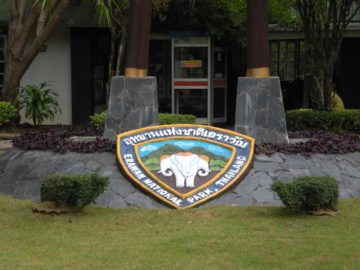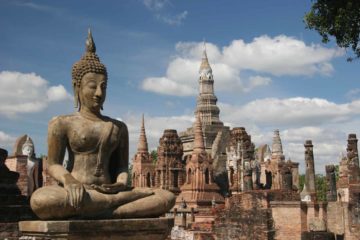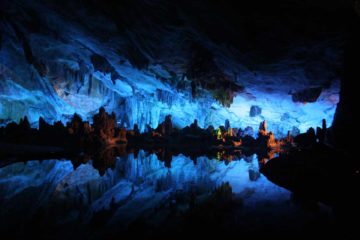About Erawan Waterfall (Nam tok Erawan)
The Erawan Waterfall was really an impressive series of seven waterfalls each with a shape and character all its own. All the waterfalls typically fell over limestone cliffs resulting in colorful plunge pools as well as interestingly rounded rock formations reminiscent of something that would belong in a cave. Moreover, we also saw some unsigned waterfalls that seemed legitimate but didn’t appear to count towards the seven.
In any case, we thought this waterfall had it all – the scenery, the swimming, and the exercise. It was no wonder why it was popular and quite busy here. Of course, given how typically hot it was in this part of Thailand, I guess the swimming or playing in the many plunge pools of beneath these waterfalls were enticing as well as scenically alluring. It seemed like this waterfall epitomized the universal appeal of swimming beneath waterfalls in the typically humid tropical climate.
From the car park, the trail started off flat and mostly paved as it ultimately reached the first waterfall, which was called Ly Kung Lung (I also saw it spelled Hlai Keun Lung). A sign indicated that it was only a 20m walk from the visitor center area. Believe it or not, it was possible to bypass this section of walking by taking a tram to that visitor center area. We didn’t do the tram option as we thought it was a little overkill.

Yet we weren’t totally sure why there were fewer people swimming at this waterfall given how pretty it was and how there was the presence of travertine pools. Since we didn’t take a dip ourselves, we couldn’t tell you ourselves whether there was something off about the pool at this falls.
A short distance later (170m from the visitor center), the activity picked up and there were lots of people swimming, wading, and even scrambling into a small alcove behind the second waterfall (see photo at the top of this page). We thought this waterfall was one of the more scenic ones given its unusual rounded underlying limestone over which the water flowed. According to the signs here, this falls was called Wung Macha.
Given how pretty the falls was, it was no wonder why there was such bustle of activity. We had a good time taking photos from here while also chilling out and basking in the atmosphere of the scene. Come to think of it, perhaps the first waterfall might have been a perfectly fine swimming hole, but the second waterfall completely overshadowed it thereby causing it to become a victim of the lemmings effect.

On the way up, we were stopped at a check point where we had to register with the authorities there. In addition, I recalled having to leave some kind of collateral (a Thai baht deposit I believe) in exchange for the plastic water bottles we were carrying with us. Perhaps the thought was that the deposit would cover the potential clean-up costs in case the plastic was left behind.
I thought it was a good system (to minimize the amount of litter in the ecologically sensitive areas) though they probably should’ve charge a little more money to really make it attractive to bring the water bottles back here and get back the desposit.
It took a few more minutes of uphill hiking before we finally encountered the third Erawan Waterfall, which was called Pha Num tok (or Pha Nom Tok) and 220m from the visitor center. And like the first waterfall, this one also had lots of fish swimming in its plunge pool because most of the people chilled out at the second waterfall. However, this one was significantly taller than the first two (possibly 20-25m I think) though not nearly as wide.

Further up the hike, the fourth Erawan Waterfall was more of a water slide. It also had a larger drop further downstream, but it was hard to see. We saw one person scoot himself on the rounded rock of the waterslide before finally letting gravity take over. This falls was called Oke Nank Phee Seah, and it was about 520m from the visitor center.
Continuing beyond the fourth waterfall, the trail became a little less steep as it followed the watercourse responsible for all the Erawan Waterfalls. Along the way, we noticed quite a few trees wrapped around with prayer flags as well as colorful silk-like garments. Our guide said that these were meant to have religious significance while also doubling as informal trail markers.
The 5th waterfall (called Bua Mai Long and 1.12km from the visitor center) was just another set of small cascades set amongst limestone with lots of travertine pools in the area. Given the relative calm and accessibility of these smaller travertine pools, we saw a handful of people swimming and chilling out here. Since it definitely lacked the amount of activity of the 2nd waterfall (probably due to the increased amount of exertion to get here), we could understand why this spot was a good alternative swimming hole to the second falls.

Contrasting the drama of the more primitive hiking conditions, we did spot a few more unnamed or “unofficial” waterfalls en route, which seemed to be even more naturesque than before. But ultimately, this fairly immersive part of the hike terminated at the sixth waterfall, which was a wide multitiered cascade with some lower tiers. This waterfall was called Dong Prouck Sa, and it was 1.42km from the visitor center.
The plunge pool beneath the sixth falls had a nice color, which I’d imagine would’ve been even more vibrant had the sun been out. Unfortunately for us, the sun hid behind the clouds when we finally made it up to this part of the hike.

This part of the trail involved more stream walking, more rickety ladders, and even a few narrow and drop-off-exposed sections. The drop-offs weren’t tall enough to induce butterflies in our stomachs, but they were enough to cause injury with a slip and fall. It didn’t seem like there were many people willing to go through the effort to go all the way here, but the relative peace and quiet from making it all the way here really made the exertion worth it.
When we finally made it up to the end of the trail, we were presented with a view of the last waterfall, which was called Phu Pha Erawan. During our visit, we only saw its lower sections flow. There was supposed to be three upper segments coming down over a rounded limestone precipite that would’ve given the falls the appearance that there were three elephant trunks.

On the return hike going back the way we came, it went by much faster as it was all-downhill. However, we still had to go back through the scrambling paths and rickety ladders both between the fifth and seventh waterfalls. It wasn’t until we made it past the scrambling section that the hike was pretty smooth sailing for the most part.
When we got back to the second waterfall, Julie and I were quite surprised at how it seemed like there were even more people frolicking in the area. Wasn’t the park supposed to be closed? Nonetheless, this further made it apparent to us that while the Erawan Waterfalls were a popular attraction, it was really the second waterfall where the vast concentration of visitors remained.
Our visit to all seven of the Erawan Waterfalls took us about 3.5 hours. It very easily could’ve been longer if not for the fact that the park was closing during our trip, which hastened our pace. Although we were accompanied by our guide, it probably wasn’t necessary to do this hike with a guide since the entire trail was well-marked except for the very end (which we’ll get to why that was at further below).
Related Top 10 Lists
No Posts Found
Trip Planning Resources
Nearby Accommodations
This content is for members only. See Membership Options.Featured Images and Nearby Attractions
This content is for members only. See Membership Options.Visitor Comments:
Got something you'd like to share or say to keep the conversation going? Feel free to leave a comment below...No users have replied to the content on this page
Visitor Reviews of this Waterfall:
If you have a waterfall story or write-up that you'd like to share, feel free to click the button below and fill out the form...No users have submitted a write-up/review of this waterfall




